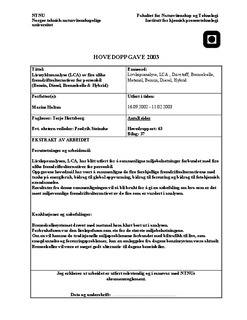| dc.contributor.author | Holtan, Marius | nb_NO |
| dc.date.accessioned | 2014-12-19T12:34:52Z | |
| dc.date.available | 2014-12-19T12:34:52Z | |
| dc.date.created | 2007-02-27 | nb_NO |
| dc.date.issued | 2003 | nb_NO |
| dc.identifier | 122136 | nb_NO |
| dc.identifier.uri | http://hdl.handle.net/11250/242621 | |
| dc.description.abstract | In this comparative lifecycle analysis (LCA) four different lifecycle systems for passenger traffic was compared in how much environmental stress they inflict. The reference system used in the analysis is the lifecycle system for an ordinary car running on gasoline, it was compared to three similar lifecycle systems composed of a diesel run car, a gasoline hybrid and a fuel cell car running on methanol. The basis in the different lifecycle systems was taken from existing infrastructure and production plants in Norway, like the refinery at Mongstad or the methanol plant at Tjeldbergodden, to give the best and most accurate description of the lifecycle systems like they would appear in Norway today if they already existed. Average data have been used for the types of car whenever possible to obtain and fulfill the functional unit.
The functional unit used in the LCA was set as a distance of 150 000 km driven by each of the car types for the different lifecycle systems.
All data collected on emissions from the different systems are scaled in accordance with this functional unit for the analysis.
The lifecycle systems were divided into four separate phases, both to simplify the systems and to make them similar enough to compare them against each other. These consist of the following: Oil and Gas production, Fuel production, Fuel transport and the fuel consumption phase.
The results of the analysis show that the lifecycle system for a fuel cell car is superior to the other three systems from an environmental viewpoint. The fuel cell system had the smallest contributions to all of the four impact categories considered in the analysis, and as such is considered the most environmentally friendly option for passenger traffic in Norway.
The reference system, consisting of the gasoline run car, performed poorly compared to the other three systems in all the impact categories considered in the analysis. This means that you could get an environmental gain by changing the existing system into any of the three alternatives in this analysis.
The fuel consumption phase is the lifecycle phase contributing the most to the total environmental load in all four of the life cycle systems. This holds true for all the impact categories considered in this analysis.
The different impact categories were not weighted against each other to obtain the final result in the analysis. This never resulted in any difficulties in the analysis since the results were one-sided for all the impact categories considered, which meant the impact categories never had to be weighted against each other.
If the goal is to combat the traditional and most visible environmental effects associated with car traffic, like formation of smog or acidification, then the fuel cell system considered in this analysis would be an excellent alternative to the gasoline based system of today. | nb_NO |
| dc.description.abstract | I denne komparative livsløpsanalysen ble fire ulike alternative livsløpsystemer for persontransport sammenlignet for de miljøbelastningene de påfører naturen. Det ble tatt utgangspunkt i et referansesystem bestående av et livsløpssystem for en bensinbil, som ble sammenlignet med tre andre systemer bestående av dieselbil, hybridbil og brenselcellebil. Det ble tatt utgangspunkt i eksisterende infrastruktur og anlegg i Norge, som raffineriet Mongstad og metanolfabrikken på Tjeldbergodden for å gi et best mulig og realistisk bilde av systemene slik de ville vært i Norge i dag. Det ble benyttet data for gjennomsnittlige biltyper, der dette har vært tilgjengelig, for å oppfylle funksjonell enhet. Funksjonell enhet i analysen ble satt til å være 150 000 km utkjørt distanse med den aktuelle biltypen for hvert av de fire livsløpssystemene, alle data og utslipp relateres i forhold til dette i oppgaven. Livsløpssystemene ble delt i fire livsløpsfaser både for å forenkle systemene og gjøre dem mest mulig sammenlignbare i analysen. Disse er olje- og gassproduksjon, produksjon av drivstoff, transport av drivstoff og forbruksfase for drivstoff.
Resultatene fra analysen viser at livsløpssystemet for brenselcellebil er overlegen i forhold til de tre andre livsløpssystemene, sett fra et miljømessig standpunkt. Brenselcellesystemet hadde minst bidrag til alle de fire effektkategoriene som ble vurdert i analysen og kan som sådan anbefales som det mest miljøvennlige om en skal planlegge en omlegging av transportsektoren i Norge. Referansesystemet, bestående av bensinsystemet, kom verst ut i analysen i alle de kategoriene som ble undersøkt. Det vil dermed være en miljøgevinst å hente ved å legge om til et av de andre systemene som er undersøkt i analysen.
Forbruksfasen har mest å si for resultatene uavhengig av hvilket system eller type miljøbelastning en undersøker.
De ulike effektkategoriene ble ikke vektet mot hverandre da en skulle komme frem til den endelige konklusjonen i analysen. Dette var aldri et problem i analysen, da resultatet ble det samme for alle de fire effektkategoriene, slik at en anbefaling kunne bli gjort uten å vurdere hva som burde veid tyngst av de fire effektkategoriene.
Om en vil komme de tradisjonelle og mest synlige problemene assosiert med biltrafikk til livs, som smogdannelse og forsuringsproblemer, vil brenselcellesystemet som ble vurdert i denne analysen være et meget godt alternativ til dagens bensinsystem. | nb_NO |
| dc.language | nor | nb_NO |
| dc.publisher | Department of Chemical Engineering | nb_NO |
| dc.title | Livssyklusanalyse (LCA) av fire ulike fremdriftsalternativer for personbil (bensin, diesel, brenselcelle og hybrid) | nb_NO |
| dc.type | Master thesis | nb_NO |
| dc.contributor.department | Norges teknisk-naturvitenskapelige universitet, Fakultet for ingeniørvitenskap og teknologi, Program for industriell økologi | nb_NO |
